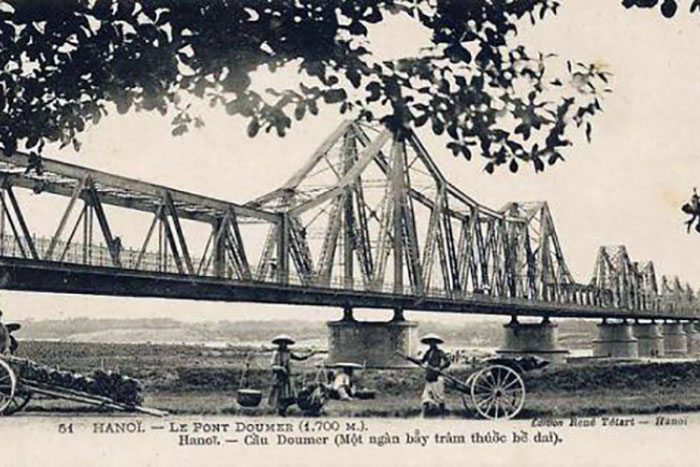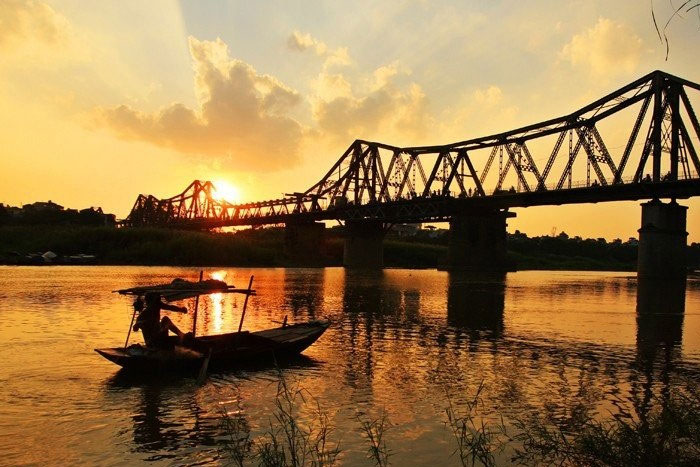Discovering Hanoi : Visit Long Bien Bridge In Hanoi, Vietnam

If you've ever strolled across the bustling streets of Hanoi, you've likely caught sight of a majestic structure spanning the Red River – the Long Bien Bridge. But beyond its architectural grandeur lies a rich history that dates back over a century. So in this short blog, allow me to be your guide to all you need to know about Long Bien bridge Hanoi.
1. The history of Long Bien bridge

Originally known as the Paul Doumer Bridge, this iconic landmark was constructed between 1898 and 1902 by the renowned Daydé & Pillé company. Its inception marked a significant chapter in Hanoi's development, connecting the districts of Hoan Kiem, Ba Dinh, and Long Bien.
The bridge's construction was no small feat, involving meticulous planning and execution. Over 3,000 local workers and a team of French engineers and experts were mobilized to bring this engineering marvel to life. Thousands of tons of stone and metal were painstakingly assembled to create its impressive 2,290-meter span.
Initially designed with traffic flowing on the right side, the bridge's traffic pattern shifted due to heavy loads of goods transported from Northern Vietnam to the port of Hai Phong. As trucks laden with cargo traveled towards Hai Phong, the imbalance in weight caused the bridge to tilt gradually to the right. To address this, traffic was redirected to the left side, creating an unusual but effective solution to the problem.
Throughout its existence, the Long Bien Bridge has undergone transformations to meet the evolving transportation needs of the region. Initially constructed for railway use, it was later expanded to accommodate road traffic, reflecting the growing demand for transportation infrastructure.
But the bridge's significance extends beyond its structural prowess. It bears witness to Vietnam's tumultuous past, including the country's struggle for independence from colonial powers. During its construction, many Vietnamese laborers tragically lost their lives, a poignant reminder of the sacrifices made in the pursuit of progress.
During the Vietnam War, the bridge faced numerous bombings by American aircraft, resulting in significant damage to its spans and pillars. Despite the destruction, the bridge remained standing, a testament to the resilience of the Vietnamese people. Its elevated points strategically positioned on the Red River served as anti-aircraft artillery positions, defending against aerial attacks during the war.
In the post-war era, as urbanization and traffic congestion increased, the Long Bien Bridge was restricted to railway, bicycle, and pedestrian use. To alleviate congestion and meet modern transportation needs, the Chuong Duong Bridge was constructed, providing an alternative route for motorbike traffic across the Red River.
Over the years, the Long Bien Bridge Hanoi has stood as a symbol of resilience, surviving wars, conflicts, and the ravages of time. It has borne witness to Hanoi's transformation from a colonial outpost to a thriving metropolis, mirroring the city's growth and evolution.
Today, as you walk across its weathered steel girders, you can't help but feel a sense of reverence for the history it embodies. The faded metal plaque bearing the inscription of its construction period serves as a silent testament to the generations that came before us, their stories etched into the very fabric of the bridge.
Despite the passage of time, the Long Bien Bridge Hanoi remains an integral part of Hanoi's identity – a testament to the resilience and spirit of its people. And as it continues to stand tall against the backdrop of modernity, it reminds us of the enduring power of history to shape our lives.
2. How to visit Long Bien Bridge

By Taxi or Ride-Hailing Services: The easiest way to get to Long Bien Bridge is by taxi or ride-hailing services like Grab. Simply input "Long Bien Bridge" as your destination, and the driver will take you directly there. Taxis and ride-hailing services are readily available throughout Hanoi.
By Motorbike or Bicycle: If you're feeling adventurous and prefer to explore the city on your own terms, you can rent a motorbike or bicycle. Navigate through the streets of Hanoi towards the Red River, and you'll find signs leading to Long Bien Bridge. Just be cautious of traffic, especially during peak hours.
By Public Bus: Hanoi's public bus system provides another budget-friendly option for reaching Long Bien Bridge. Look for buses that pass through or near the bridge's vicinity, such as bus routes 34, 55, or 59. You can check with locals or consult a map to find the nearest bus stop and plan your route accordingly.
By Walking: If you're staying in the Old Quarter or nearby areas, you can also opt to walk to Long Bien Bridge. It's a pleasant stroll that allows you to soak in the sights and sounds of Hanoi's bustling streets. Follow directions towards the Red River, and you'll eventually arrive at the bridge's entrance.
3. Some tips for your visit to Long Bien bridge
Check the Weather: Hanoi's weather can be unpredictable, so it's essential to check the forecast before your visit. Bring appropriate clothing and gear, especially if you plan to explore the bridge on foot or by bicycle.
Choose the Right Time: Consider visiting the bridge during the early morning or late afternoon to avoid the sweltering midday heat and crowds. These times also offer beautiful lighting for photography.
Wear Comfortable Shoes: If you plan to walk or bike across the bridge, wear comfortable shoes suitable for exploring. The bridge's surface may be uneven, so sturdy footwear is essential.
Stay Hydrated: Carry a water bottle with you, especially during hot weather, to stay hydrated while exploring the bridge and its surroundings.
Respect Local Customs: The Long Bien Bridge is not only a tourist attraction but also a functioning railway bridge used by locals. Be mindful of pedestrians, cyclists, and railway traffic while exploring the area.
Mind Your Belongings: Keep your belongings secure and be vigilant, especially in crowded areas. Pickpocketing can occur in tourist areas, so keep your valuables close to you.
Bring a Camera: Don't forget to bring your camera or smartphone to capture the stunning views of the Red River and the bridge itself. Sunrise and sunset are particularly picturesque times for photography.
Explore Nearby Attractions: Take the opportunity to explore other nearby attractions, such as the Old Quarter or the Hanoi Citadel, before or after visiting Long Bien Bridge. This allows you to make the most of your time in Hanoi.
Respect Local Residents: Remember that the Long Bien Bridge is not just a tourist spot but also a part of daily life for local residents. Be respectful of their privacy and property while exploring the area.
Related travel guide
Other similar articles
CUSTOMIZABLE BY LOCAL EXPERTS
Personalized trip at the original price!
REFUND GUARANTEE
We believe in our work and promise to give you money back.
GOOD PRICE / QUALITY
95% satisfied more than expected!
24/7 LOCAL SUPPORT
We are always available online to provide assistance at any time.
Most read articles
Autour Asia is highly recommended on
Embracing the mission of "Satisfied more than expected" and providing authentic experiences, we have received numerous recommendations on reputable travel forums:























